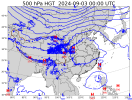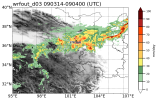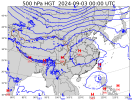Hi everyone,
I have a question about the feedback mechanism in WRF nesting.
In one of my cases, when I turn feedback = 1, I notice that small-scale perturbations appear on the geopotential height field (at pressure levels) in domain 1. These perturbations are mainly located within the area covered by domain 3.
However, the precipitation simulation looks fine — the rainfall pattern and intensity don’t change much compared with the case when feedback = 0. When I disable feedback, those small disturbances on domain 1 disappear, and the large-scale fields look smoother.
So I have a few questions:
1. Why do these small perturbations appear on domain 1 when feedback is turned on?
2. How exactly does the feedback mechanism work in WRF (e.g., what variables are passed back, and how are they averaged)?
3.For mesoscale extreme rainfall cases, is it recommended to enable feedback, or would it be better to keep feedback off to avoid contaminating the large-scale fields?
Any explanations, references, or experiences are very welcome. Thanks a lot!
feedback=1:


feedback =0:


namelist.input:
&time_control
run_days = 1,
run_hours = 03,
run_minutes = 0,
run_seconds = 0,
start_year = 2024, 2024, 2024,
start_month = 09, 09, 09,
start_day = 03, 03, 03,
start_hour = 03, 03, 03,
end_year = 2024, 2024, 2024,
end_month = 09, 09, 09,
end_day = 04, 04, 04,
end_hour = 06, 06, 06,
interval_seconds = 3600,
input_from_file = .true., .true., .true.,
history_interval = 15, 15, 15,
frames_per_outfile = 1, 1, 1,
restart = .false.,
io_form_history = 2,
io_form_restart = 2,
io_form_input = 2,
io_form_boundary = 2,
debug_level = 0,
/
&domains
time_step = 27,
time_step_fract_num = 0,
time_step_fract_den = 1,
max_dom = 3,
e_we = 710, 796, 1453
e_sn = 522, 703, 1027
e_vert = 50, 50, 50,
p_top_requested = 5000,
num_metgrid_levels = 38,
num_metgrid_soil_levels = 4,
dx = 9000, 3000,1000,
dy = 9000, 3000,1000,
grid_id = 1, 2, 3,
parent_id = 1, 1, 2,
i_parent_start = 1, 184, 139
j_parent_start = 1, 177, 198
parent_grid_ratio = 1, 3, 3,
parent_time_step_ratio = 1, 3, 3,
smooth_option = 0,
use_surface = .true.,
sfcp_to_sfcp = .true.,
feedback = 0,
/
&physics
mp_physics = 8, 8, 8,
ra_lw_physics = 4, 4, 4,
ra_sw_physics = 4, 4, 4,
radt = 9, 9, 9,
sf_sfclay_physics = 1, 1, 1,
sf_surface_physics = 2, 2, 2,
bl_pbl_physics = 1, 1, 1, ! YSU
bldt = 0, 0, 0,
cu_physics = 1, 1, 0,
cudt = 5, 5, 5,
isfflx = 1,
ifsnow = 0,
icloud = 1,
num_land_cat = 21,
sf_urban_physics = 0, 0, 0,
/
&dynamics
w_damping = 1,
diff_opt = 1, 1, 1,
km_opt = 4, 4, 4,
diff_6th_opt = 0, 0, 0,
diff_6th_factor = 0.12, 0.12, 0.12,
base_temp = 290.,
damp_opt = 3,
zdamp = 5000., 5000., 5000.,
dampcoef = 0.2, 0.2, 0.2,
khdif = 0, 0, 0,
kvdif = 0, 0, 0,
non_hydrostatic = .true., .true., .true.,
moist_adv_opt = 1, 1, 1,
epssm = 0.1, 0.3,0.5,
scalar_adv_opt = 1, 1, 1,
etac = 0.1
/
&bdy_control
spec_bdy_width = 5,
spec_zone = 1,
relax_zone = 4,
specified = .true., .false., .false.,
nested = .false., .true., .true.,
/
&namelist_quilt
nio_tasks_per_group = 0,
nio_groups = 1,
/
I have a question about the feedback mechanism in WRF nesting.
In one of my cases, when I turn feedback = 1, I notice that small-scale perturbations appear on the geopotential height field (at pressure levels) in domain 1. These perturbations are mainly located within the area covered by domain 3.
However, the precipitation simulation looks fine — the rainfall pattern and intensity don’t change much compared with the case when feedback = 0. When I disable feedback, those small disturbances on domain 1 disappear, and the large-scale fields look smoother.
So I have a few questions:
1. Why do these small perturbations appear on domain 1 when feedback is turned on?
2. How exactly does the feedback mechanism work in WRF (e.g., what variables are passed back, and how are they averaged)?
3.For mesoscale extreme rainfall cases, is it recommended to enable feedback, or would it be better to keep feedback off to avoid contaminating the large-scale fields?
Any explanations, references, or experiences are very welcome. Thanks a lot!
feedback=1:


feedback =0:


namelist.input:
&time_control
run_days = 1,
run_hours = 03,
run_minutes = 0,
run_seconds = 0,
start_year = 2024, 2024, 2024,
start_month = 09, 09, 09,
start_day = 03, 03, 03,
start_hour = 03, 03, 03,
end_year = 2024, 2024, 2024,
end_month = 09, 09, 09,
end_day = 04, 04, 04,
end_hour = 06, 06, 06,
interval_seconds = 3600,
input_from_file = .true., .true., .true.,
history_interval = 15, 15, 15,
frames_per_outfile = 1, 1, 1,
restart = .false.,
io_form_history = 2,
io_form_restart = 2,
io_form_input = 2,
io_form_boundary = 2,
debug_level = 0,
/
&domains
time_step = 27,
time_step_fract_num = 0,
time_step_fract_den = 1,
max_dom = 3,
e_we = 710, 796, 1453
e_sn = 522, 703, 1027
e_vert = 50, 50, 50,
p_top_requested = 5000,
num_metgrid_levels = 38,
num_metgrid_soil_levels = 4,
dx = 9000, 3000,1000,
dy = 9000, 3000,1000,
grid_id = 1, 2, 3,
parent_id = 1, 1, 2,
i_parent_start = 1, 184, 139
j_parent_start = 1, 177, 198
parent_grid_ratio = 1, 3, 3,
parent_time_step_ratio = 1, 3, 3,
smooth_option = 0,
use_surface = .true.,
sfcp_to_sfcp = .true.,
feedback = 0,
/
&physics
mp_physics = 8, 8, 8,
ra_lw_physics = 4, 4, 4,
ra_sw_physics = 4, 4, 4,
radt = 9, 9, 9,
sf_sfclay_physics = 1, 1, 1,
sf_surface_physics = 2, 2, 2,
bl_pbl_physics = 1, 1, 1, ! YSU
bldt = 0, 0, 0,
cu_physics = 1, 1, 0,
cudt = 5, 5, 5,
isfflx = 1,
ifsnow = 0,
icloud = 1,
num_land_cat = 21,
sf_urban_physics = 0, 0, 0,
/
&dynamics
w_damping = 1,
diff_opt = 1, 1, 1,
km_opt = 4, 4, 4,
diff_6th_opt = 0, 0, 0,
diff_6th_factor = 0.12, 0.12, 0.12,
base_temp = 290.,
damp_opt = 3,
zdamp = 5000., 5000., 5000.,
dampcoef = 0.2, 0.2, 0.2,
khdif = 0, 0, 0,
kvdif = 0, 0, 0,
non_hydrostatic = .true., .true., .true.,
moist_adv_opt = 1, 1, 1,
epssm = 0.1, 0.3,0.5,
scalar_adv_opt = 1, 1, 1,
etac = 0.1
/
&bdy_control
spec_bdy_width = 5,
spec_zone = 1,
relax_zone = 4,
specified = .true., .false., .false.,
nested = .false., .true., .true.,
/
&namelist_quilt
nio_tasks_per_group = 0,
nio_groups = 1,
/
